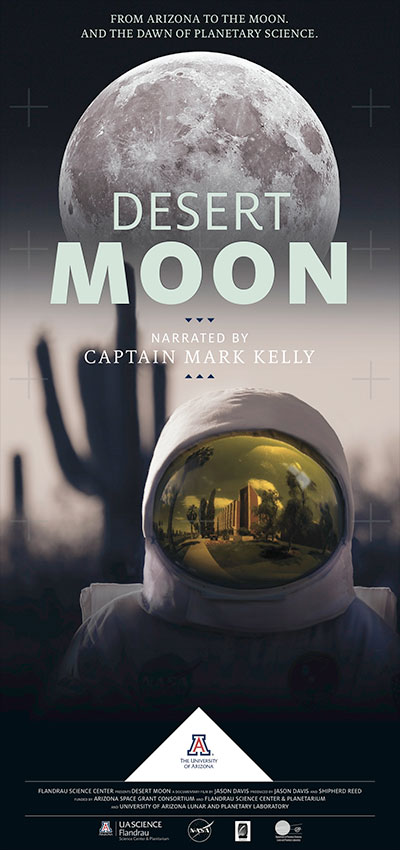A documentary premiering next week tells the fascinating and surprising stories behind the groundbreaking work that enabled NASA astronauts to successfully touch down on the moon 45 years ago and led to the birth of the University of Arizona's Lunar and Planetary Laboratory in the process.
"Desert Moon" is the brainchild of Jason Davis, who recently graduated from the UA School of Journalism. Together with co-producer Shipherd Reed of the UA's Flandrau Science Center and Planetarium, he dug into the archives and found a surprisingly rich history of the University's involvement in the moon landings.
"I had heard about telescopes that UA scientists used to map the moon, but I didn't' know if there was even enough here to make this film," he said. "Once I started looking into it, I was just shocked to see how much the UA was involved, and it took off from there."
His exploration culminated with the completion of "Desert Moon," which premieres July 4 at the Flandrau Science Center, 1601 E. University Blvd. The film will be screened Mondays and Wednesdays at 2 p.m. and Fridays and Saturdays at 7 p.m.
The film tells the surprising story of renowned astronomer Gerard Kuiper, who came to the UA to study the moon and, with his team of lunar researchers, helped the U.S. get ahead in the space race by landing a man on the moon. In the process, NASA funded the construction of the UA's Lunar and Planetary Laboratory, now a world leader in planetary science, and began a golden age of solar system exploration.
The role that Kuiper and his team of UA researchers played in the moon landing has been obscured by time, but now their story of perseverance and ingenuity has been brought to the screen. Kuiper, the most famous among them, died in 1973, but the documentary features many of the men who worked alongside Kuiper during the heyday of the space race. Kuiper's name lives on, notably in the "Kuiper Belt," a swath of asteroids that orbit the sun farther out than the planets, and in the UA's Gerard P. Kuiper Space Sciences building, which houses the Lunar and Planetary Laboratory.
"Desert Moon" explain how the groundwork laid by Kuiper and his team helped clear the way for one of the biggest moments in human history.
In 1961, when President John F. Kennedy boldly declared that the United States would land a man on the moon by the end of the decade, nobody knew if it would be possible. Surprisingly little was known about the moon at the time.
"We did not know what the composition of the moon was, we didn't know the physical state of the surface, whether you would sink into dust or whether it was rock," retired UA planetary scientist Robert Strom explains in the documentary.
Similarly, the maps that existed before Kuiper began to systematically map the surface of the moon were hand drawn and not adequate to send astronauts to the moon.
Long before the space race began, Kuiper was already looking for answers. At the University of Chicago's Yerkes Observatory, he published a groundbreaking photographic lunar atlas. To find the best telescope viewing, he looked to the Southwest. At the UA, he established the Lunar and Planetary Laboratory, one of the first planetary science research institutions in the world.
"Kuiper made the decision to make the move from Chicago in 1960, because the Southwest was the new place to be for space scientists," Davis said. "The best telescopes were here, as well as tall mountain ranges, dark skies and dry air."
Kuiper's team created detailed maps of the moon that were used by NASA to search for places where astronauts could land. He became the principal experimenter for the Ranger program, a series of missions designed to send a spacecraft to the moon for the first time and take up-close photos before it crash-landed. In the process, he established one of the first research institutions dedicated to just the solar system.
"Kuiper was visionary in that regard, one of the first to study the moon and the planets," Davis said. "At the time, that just wasn't being done. Today, LPL still is one of the leaders and involved in pretty much every NASA mission to the planets in our solar system."
The young lunar researchers on Kuiper's team were learning geology in order to understand what they were seeing on moon.
"They were the first to make detailed maps of the moon, to chart its many craters, to analyze the first close-up photos and characterize the geology of the lunar surface — all the science we needed before we could land a man on the moon," Davis said.

The research taking place at the Lunar and Planetary Laboratory provided the baseline science needed to land on the moon. Finally, on July 20, 1969 — after many missions to refine the capabilities of the U.S. space program — the Apollo 11 spacecraft landed on the moon, and hours later Neil Armstrong set foot on the lunar surface.
Kuiper's most lasting contribution was institutional. The UA's Lunar and Planetary Laboratory has trained generations of planetary scientists and has participated in every NASA spacecraft mission to explore our solar system. Thanks to the expertise built up by the lab, the UA has the distinction of being the only university to lead two NASA missions: the Phoenix Mars mission that found water at the Martian pole, and the OSIRIS-REx mission to take a pristine sample of an asteroid and return it to Earth for the first time.
The making of the documentary was funded by a NASA Space Grant administered through the Arizona Space Grant Consortium. LPL and the Flandrau Science Center and Planetarium provided additional support.












